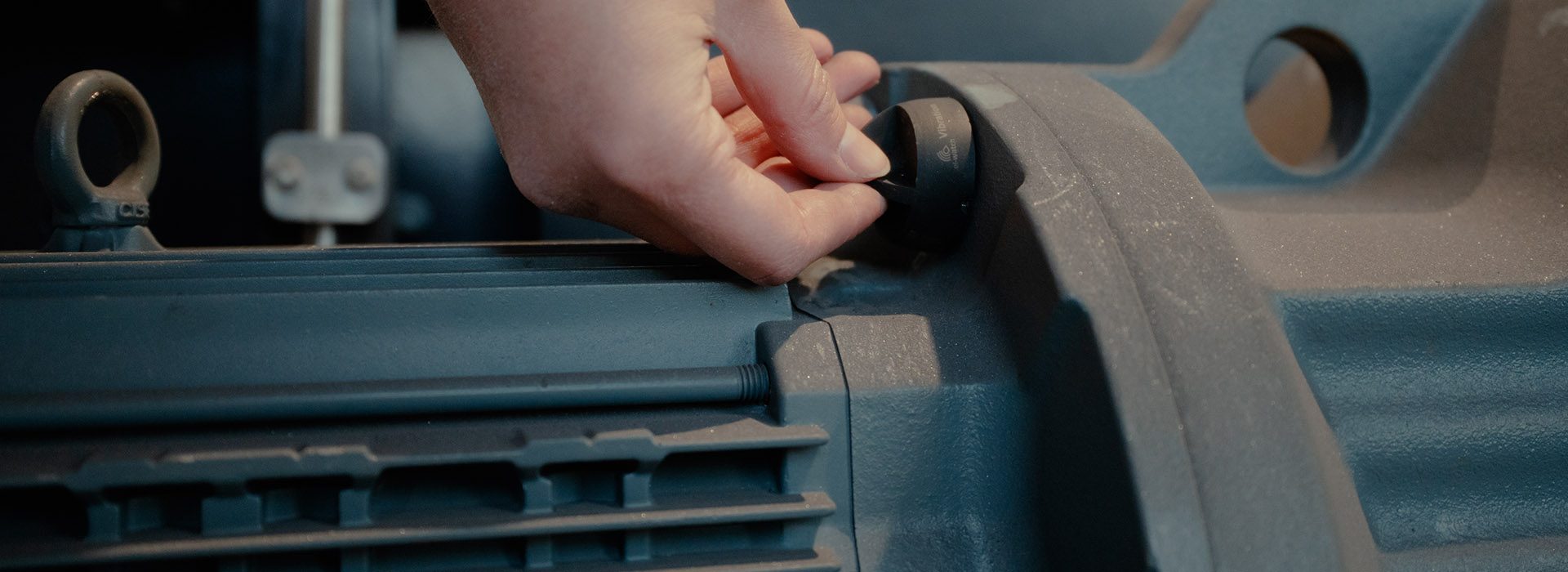Vibration sensor application gives your company a competitive edge. With a vibration monitoring system installed, you can prevent unexpected machine problems and optimize production in one fell swoop. Here is why vibration sensors are a good investment!
All industrial machinery is subject to vibrations and is prone to damage from them. Vibration sensors help companies avoid machine failure, production standstills, and costly repairs. Read on to find out all you need to know about vibration sensors.
Contents
- What is a vibration sensor?
- What are vibration sensors used for?
- How do vibration sensors work?
- Benefits of wireless vibration sensor application
- What are the most common vibration sensor types?
- How do you install vibration sensors?
- How do you test vibration sensors?
- Vibration sensor issues and solutions
- Vibration sensors promoting sustainability
- El-Watch vibration sensors: Functions and advantages
- Why are vibration sensors a good investment?
What is a vibration sensor?
A vibration sensor measures vibration frequency and intensity in machines, engines, and equipment. The readings help detect anomalies, imbalance, rubbing, adverse resonance, loose parts, etc., and ensure optimal productivity.
Industrial vibration sensors commonly operate in clusters, forming so-called vibration monitoring systems. These systems constantly monitor vibration, friction, and temperature to uncover equipment irregularities immediately.
What are vibration sensors used for?
Vibration monitoring is vital for establishing predictive maintenance in the industrial sector. Contrary to predetermined or preventive maintenance, predictive maintenance monitors and analyzes equipment continuously.
The purpose of installing vibration sensors for predictive maintenance is twofold. For one, it enables substantial savings by preventing unnecessary upkeep. Secondly, it ensures optimal machinery and equipment performance.
Related article: What is predictive maintenance? (Definition, examples, IoT solutions)
Produkt
Neuron Vibration Sensor
Neuron Vibration Sensor måler vibrasjonsnivå og overflatetemperatur hvert andre minutt. Sensoren har en innebygd magnet på baksiden for enkel installasjon.
How do vibration sensors work?
Most commonly, vibration sensors monitor acceleration or velocity in rotating machinery. Velocity measures speed in one direction, while acceleration measures the rate of change in velocity.
Acceleration monitoring is the most common type. Because it measures higher frequencies, it can detect early-onset, tiny shocks that indicate faults in pumps, bearings, gearboxes, etc.
Velocity monitoring measures lower frequencies, which identify anomalies in energy output. This is useful for spotting looseness, unbalance, and misalignment in belt drives, fans, pistons, mounting bolts, etc.
What is the unit of vibration?
Vibration sensors use several units to describe different vibration properties. Frequency is measured in Hertz (Hz). Displacement is measured in distance (m, mm, and μm). Velocity measures distance over time (cm/s or mm/s), and acceleration (in this context) measures the overall energy of random vibrations (Grms).
The nuts and bolts of industrial vibration sensors
Simply put, vibration sensors are attached to your assets to monitor vibrations. Depending on the sensor type, you’ll be left with various kinds of data. Industrial vibration sensors commonly provide data on frequency and intensity.
In this context, frequency tells you where spikes in vibration occur, while vibration intensity measurement tells you how strong those vibrations are. Together, these two sets of data can reveal the root causes of equipment issues early on.
The data sets are added to the asset’s history in your CMMS, which also contains data on previous anomalies and malfunctions. By comparing the asset’s historical data to new vibration monitoring, you can predict and correct future failures before they occur.
Benefits of wireless vibration sensor application
Machine and equipment vibrations can cause a wide array of problems. Some of the most common issues are mechanical imbalance/misalignment, bearing defects, worn gears/belts, fluid noises, loose/rubbing components, and impact damage.
Vibration sensors can detect signs of these issues in their initial phases and stop them from developing into significant problems. However, wired vibration monitoring systems can be expensive and time-consuming to install and upgrade since they require production to be paused during installation.
Wireless vibration sensors, on the other hand, are less costly, quick to install, and easily scaled in line with manufacturing expansion. Remote vibration sensors also have the benefit of accessibility; their data can be retrieved anywhere on your phone or laptop.
Predictive maintenance by vibration monitoring equipment is like mechanical healthcare. Regular checks prevent severe issues from surfacing. Early detection enables counteractions and keeps the system healthy and operational for as long as possible.
What are the most common vibration sensor types?
There are many types of vibration sensors for various uses and purposes. Some are used for accident prevention or measuring seismic activity. The ones we focus on in this article are made for industrial purposes. These are the most common sensor types:
Accelerometer
Accelerometers are used to detect changes in velocity. They are inexpensive and effective at detecting vibrational anomalies. Accelerometers are usually divided into three groups: MEMS, piezoelectric, and piezoresistive.
Gyroscope
Gyroscopes measure rotation velocity by MEMS (Microelectromechanical Systems). They are usually not used alone but with an accelerometer to improve vibration monitoring accuracy.
Strain Gauge
A strain gauge is a foil with an electric grid for vibration measurement on curved or uneven surfaces. The current in the grid changes upon stretching or compressing. Strain gauges are versatile but rather expensive, and installation can be tricky.
Eddy Current Sensor
Eddy current sensors are not directly attached to your equipment but measure vibration using magnetic waves. They are suited for measuring vibrations in delicate equipment, which is why they are primarily used in laboratories.
Laser Displacement sensor
Laser displacement sensors measure vibration by laser triangulation. This can be useful when adequate sensor attachment is impossible or when the sensor weight affects the vibration of lightweight equipment. The price is high, however.
Microphone Sensor
Microphones pick up vibrations in the air. They are well suited for detecting vibrational changes over time but not so much for pinpointing vibration sources. Microphone sensors, therefore, tend to be used together with accelerometers.
Vibration Meter
Vibration meters are portable devices for quick vibration monitoring of equipment. They are suitable for routine checks of industrial equipment health but cannot provide long-term assessment data.
Magnetic Velocity Sensor
Magnetic velocity sensors became outdated when cheaper accelerometers could get the same job done. The only advantage is that these sensors can operate at very high temperatures.
How do you install vibration sensors?
Installation differs significantly between wired and wireless vibration sensors. Wired sensors require extensive planning, a production halt, and proper security measures, whereas wireless sensors are much less obtrusive and quick to install.
The benefit of wired sensors is continuous monitoring, and they are well-suited for emergency stop systems. However, it does require clearing cable pathways and sometimes customizing equipment to accommodate sensor placement.
Wireless sensors, on the other hand, are easy to install, either with magnets or adhesives. This makes wireless sensor installation much cheaper. Wireless vibration monitoring happens at regular intervals, which is more than sufficient in almost all cases.
Produktbrosjyre
Finn den perfekte løsningen
Vibration sensor issues and solutions
Vibration sensors can save companies many headaches and expenses. However, faulty installation and environmental disturbances can result in inaccurate readings and other vibration sensor issues. Here are the most common problems and how to solve them:
Accelerometer sensitivity issues
Incorrect sensitivity values or improper accelerometer types are common issues that result in faulty vibration monitoring. Make sure to choose an accelerometer that fits your system requirements, and pay special attention to your sensor’s calibration. Apps for this particular purpose make the process easier, like our Neuron Sensor App.
Accelerometer mounting issues
If your vibration sensor is not adequately mounted or oriented in the wrong direction, the data it collects might be invalid. If you are unsure, find qualified personnel to check the quality of your sensor mounting. El-Watch is here to help.
Wired vs. wireless sensor issues
Cables shaking loose or disturbing vibration monitoring are common issues. Certain environments can render wireless sensor readings difficult, like fully closed metal compartments. However, in most cases, remote vibration sensors will save you the costly complications of cable issues.
Noise floor issues
Sometimes, background noise cancels out useful frequencies. This happens if the vibration of the machine itself is stronger than the vibration of the motor the sensor is mounted on. A change in frequency of interest will usually help to avoid noise floor issues.
Vibration data analysis issues
Proper vibration monitoring requires data gathering and analysis. The numbers can seem daunting, but well-planned management makes it less troublesome. Choose sensors based on what kind of data they collect and set up a plan for data analysis. IoT vibration sensors and software tools can streamline this process considerably.
Vibration sensors promote sustainability
Vibration sensors are integral to predictive maintenance, which enables energy savings, more efficient production, and fewer wasted resources in the industrial sector. The data picked up by these sensors reveals how much strain your equipment can handle and when it needs upkeep.
Vibration monitoring systems make entire industries more proficient. It promotes social, economic, and environmental sustainability. Check out our article about how wireless sensors enable a sustainable manufacturing industry to find out more.
El-Watch vibration sensors: Functions and advantages
El-Watch’s Neuron Vibration is a robust wireless sensor that measures vibration and temperature. Together, these two parameters give you a better understanding of your machine’s performance and condition.
Attaching Neuron Vibration sensors with magnets is easy and long-lasting. They have a lifespan of about ten years. The Neuron Sensor App makes data analysis easy. Additionally, you can set a vibration sensor alarm to notify you of anomalies via SMS, push notification, or e-mail.
Neuron Vibration enables effective anomaly detection and preventive maintenance. It also provides machine status data to improve efficiency and insight. Alternatively, it can monitor uptime hours or structural integrity and notify users when to engage in usage-based upkeep.
Why are vibration sensors a good investment?
Vibration sensors are by far the best tools for detecting equipment deterioration and engaging in preventive maintenance. Early uncovering of imbalance, misalignment, rubbing, loose parts, etc., prevents unnecessary downtime and costly repairs.
Furthermore, vibration sensors provide valuable data on machine conditions. This insight enables more efficient production since machines and equipment can be safely pushed to their output limits.
Klar for å prøve trådløse sensorer?
Resources
DES: Sinusoidal and Random Vibration Testing Primer
Digi-Key: Vibration Sensor Applications and Solutions
IFM: Vibration Monitoring Application Solutions
Mechatronika (ME): Design and performance evaluation of smart vibration sensor for industrial applications with built-in MEMS accelerometers
NDT & E International: Vibration monitoring for defect diagnosis of rolling element bearings as a predictive maintenance tool: Comprehensive case studies
Omega: Vibration Sensors and Their Importance in Vibration Monitoring of Rotating and/or Reciprocating Machines
Processing: Benefits of vibration sensors in multiple applications
Scheffer, Cornelius & Girdhar, Paresh: Practical Machinery Vibration Analysis and Predictive Maintenance





